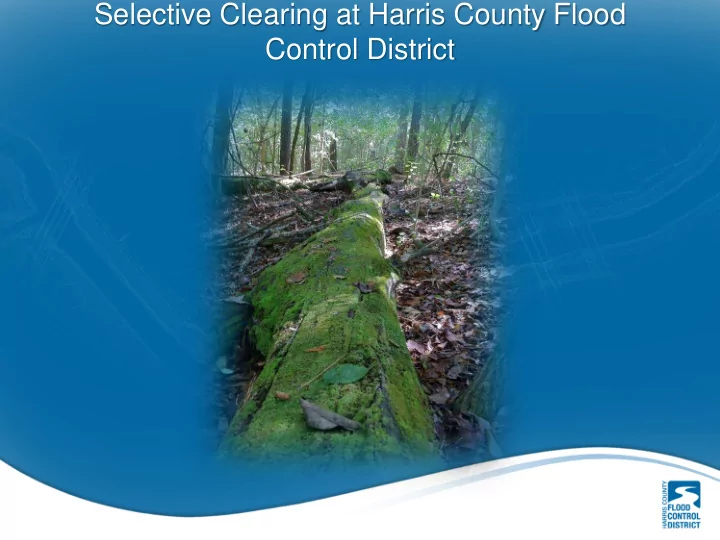

Selective Clearing at Harris County Flood Control District
Shane Hrobar Vegetation Management Coordinator • Texas A&M – B.S. Forest Management • ISA Certified Arborist
OUR MISSION Provide flood damage reduction projects that work, with appropriate regard for community and natural values.
Harris County Flood Control District • A special purpose district created in 1937 by the Texas legislature • In response to floods that devastated the Houston-area in 1929 and 1935 • Serves as a local partner to leverage federal tax dollars for flood damage reduction • Harris County Commissioners Court serves as our board of directors or governing body
Harris County Watersheds
Harris County Open Channel Network
Goals of Selective Clearing – Maintain conveyance in a wooded, natural section of a channel – Reduce maintenance by promoting or preserving canopy closure – Maintain healthy root structure which helps stabilize slopes – Reduction of invasive and undesirable species – Find a compromise between a complete removal of woody vegetation and a complete lack of maintenance.
Desirable Vs. Undesirable Vegetation • An American sycamore, typically a very desirable species, may have grown up on the toe line of a channel. The tree and it’s exposed root system are catching large amounts of debris and are causing the channel find a way around. The channel is narrow and there isn’t much room to move. This tree becomes an undesirable specimen and should be removed. • A grouping of Chinese tallow, typically an undesirable species, may be the only trees established on the bank of a channel segment that is highly susceptible to erosion. The roots of the tallow may hold the soil of the bank in place, indicating that the tree should be left in place until more desirable species are established.
Achieving The Goals – Based on all open channels that are not categorized into any sort of scheduled maintenance – List of channels is broken into Phases, based on a large watershed or group of smaller watersheds – Channels are assessed, project limits are defined and the list is modified – There are 8 Phases in the program at this point estimated at 4,500 acres. – Hope to finish all Phases around 2020.
Achieving The Goals – Harris County Purchasing Department advertises, awards and administers the contracts for our department – Vegetation Management writes the specifications and manages the contracts – Currently a term contract with the option to renew for four more years – Vegetation Management Inspectors are assigned to the contract to inspect work and ensure that it is performed to specifications
Achieving The Goals – Production metrics are in place to make sure that a minimum amount of acres are completed each year. Penalties are in place if a contractor does not meet minimum specified quantities. – Completed channels are placed into some sort of maintenance – Our Inspector and interns (hopefully) spend Spring and early Summer months assessing future sites and examining developing conditions on old sites
Selective Clearing W142-00-00 Before
Selective Clearing W142-00-00 After
Selective Clearing S101-02-00 Before
Selective Clearing S101-02-00 After
Future Maintenance Considerations • Mowing/Cyclical Maintenance • How do we continue to reduce • How do we eliminate it • Reforestation and diversification • Site selection • Site preparation • Planting density • Diversity considerations • Getting them in the ground • Development • Revising the project locations to avoid areas of future development
Selective Clearing Lessons • Balancing public opinion and expectations • Managing and working in sensitive areas • White Oak Bayou • Buffalo Bayou • Brays Bayou • Contractor issues • This isn’t mowing – issues understanding specs and scope of work • Where do we find them? • How can we take what we have learned from past years and apply them to future sites?
Questions?
Recommend
More recommend